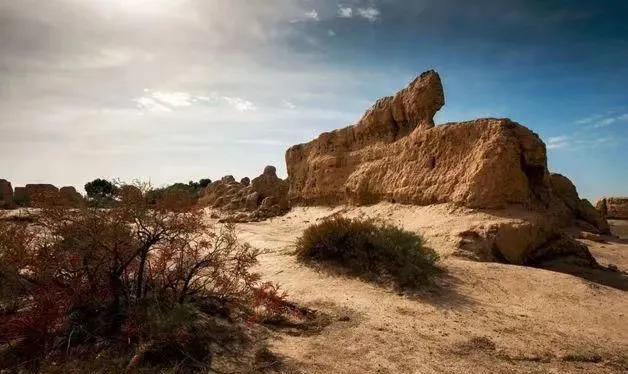About three or four years ago, Wuwei just started the construction of a new urban area, the river above the South Lake of Haizang is still planned, there are a few weeks every weekend, I like to ride a motorcycle with my children to the river to play, see the long river is covered with messy stone debris, I just want to pick up a special stone to play. As a result, I found several pieces of Ming and Qing Qing blue and white plate porcelain pieces at a beach pile in the river, one with a Tianzi model on the bottom, one with a Ruyi Lingzhi pattern, or a piece of transparent linglong porcelain that was rare to see, so I carefully installed it. I also picked up a lotus pattern stone base, which is estimated to be an ancient building component, and also picked up a round pottery object similar to the teapot lid, and I couldn't judge what it was, so I brought it back together. Later, I put this round pottery cover to the garbage lane for a month, which is strange to say, just after I checked the cultural relics unearthed by the Qi family culture of the Imperial Niangniangtai on my mobile phone, I accidentally found that the thing that I threw away was most likely the textile of the Qi family culture, and I regretted it. After that, I found dozens of strip pits ranging from 1 meter deep and width and several meters long to more than ten meters in the abandoned farmland on the riverbank, which was very curious, and later I learned that it was the pit left by the archaeological excavation of the Qi family culture of the Imperial Niangniang. I remember unearthing a large number of Qi family culture jade, small pieces of copper, pottery and other rich burial items. Past the Xingye Pension Center, a deserted beach with a dry Shiyang River to the south and a large abandoned brick cellar to the north. I wandered around in this idle beach open space, immediately found something wrong, first looked around, there are some dwarf stacks similar to beacons or city walls on the field, a look is full of historical sense of sang, occasionally you will encounter a large number of Han Dynasty square bricks, and some ceramic tiles, as well as some stone cutters similar to primitive people, I immediately judged that this is an ancient city ruins, sure enough, and then I saw that the Wuwei New City planning behind the Emperor Tai this area behind the unsurprising looking area to plan a Suoyang City Ruins Park, It seems that the place I have been to is it.
After investigation, it was confirmed that the site was located 200 meters south of Zhao Jia Mo Village, Jinyang Township, Liangzhou District, Wuwei City. It is a large earthen ancient city. Also known as Three Mule Cities. The city plan is rectangular, 1000 meters wide from east to west, and the specific length is unknown due to the fact that it was washed away by the Shahe River. The walls of the city were destroyed and the site of the gate is unknown. There are 2 existing Ming Dynasty temple sites, only rammed earthen platforms, with a residual height of 2 meters. The ground is scattered with fragments of gray pottery and Han bricks, and many pieces of ware such as clay gray pottery have been excavated. According to the "Later Han Shu Dou Rong Biography" Li Xian's annotations to the "Old Events of the West River", "Later Han Shu Guangwu Emperor's Chronicle" Li Xian's notes, "Water Classics Notes" volume 40 citing "Wang Yinjin Book", Qing Shunzhi "Reprinting Ganzhen Zhi, Liangzhou Wei Ancient Monuments" and other historical records to verify that the city should be the Xiongnu Gaizang City, the former site of the Western Han Guzang County. From the end of the Western Han Dynasty to the beginning of the Eastern Han Dynasty, the county seat of Guzang was moved to the present Wuwei City, and the city was abandoned. The poor preservation of the city site is of great value to the study of the history of urban construction and the history of Wuwei in the Han Dynasty.
